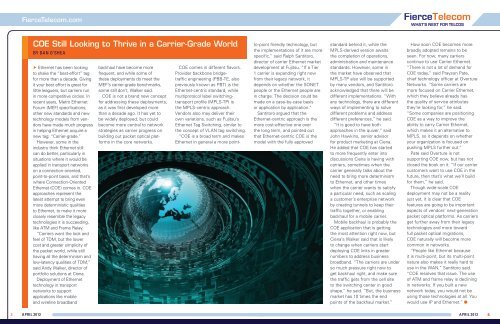Connection Oriented Ethernet - InfoVista
Connection Oriented Ethernet - InfoVista
Connection Oriented Ethernet - InfoVista
Create successful ePaper yourself
Turn your PDF publications into a flip-book with our unique Google optimized e-Paper software.
FierceTelecom.com<br />
3 April 2012<br />
COE Still Looking to Thrive in a Carrier-Grade World<br />
BY DAN O’SHEA<br />
� <strong>Ethernet</strong> has been looking<br />
to shake the “best-effort” tag<br />
for more than a decade. Giving<br />
it your best effort is great for<br />
little leaguers, but carriers run<br />
in more competitive circles. In<br />
recent years, Metro <strong>Ethernet</strong><br />
Forum (MEF) specifications,<br />
other new standards and new<br />
technology models from vendors<br />
have made much progress<br />
in helping <strong>Ethernet</strong> acquire a<br />
new tag: “Carrier-grade.”<br />
However, some in the<br />
industry think <strong>Ethernet</strong> still<br />
can do better, particularly in<br />
situations where it would be<br />
applied in transport networks<br />
on a connection-oriented,<br />
point-to-point basis, and that’s<br />
where <strong>Connection</strong>-<strong>Oriented</strong><br />
<strong>Ethernet</strong> (COE) comes in. COE<br />
approaches represent the<br />
latest attempt to bring even<br />
more deterministic qualities<br />
to <strong>Ethernet</strong>, to make it more<br />
closely resemble the legacy<br />
technologies it is succeeding,<br />
like ATM and Frame Relay.<br />
“Carriers want the look and<br />
feel of TDM, but the lower<br />
cost and greater simplicity of<br />
the packet world, while still<br />
having all the determinism and<br />
low-latency qualities of TDM,”<br />
said Andy Walker, director of<br />
portfolio solutions at Ciena.<br />
Deployment of <strong>Ethernet</strong><br />
technology in transport<br />
networks to support<br />
applications like mobile<br />
and wireline broadband<br />
backhaul have become more<br />
frequent, and while some of<br />
these deployments do meet the<br />
MEF’s carrier-grade benchmarks,<br />
some still don’t, Walker said.<br />
COE is not a brand new concept<br />
for addressing these deployments,<br />
as it was first developed more<br />
than a decade ago. It has yet to<br />
be widely deployed, but could<br />
become more central to network<br />
strategies as carrier progress on<br />
building out packet optical platforms<br />
in the core networks.<br />
COE comes in different flavors.<br />
Provider backbone bridgetraffic<br />
engineering (PBB-TE, also<br />
previously known as PBT) is the<br />
<strong>Ethernet</strong>-centric standard, while<br />
multiprotocol label switchingtransport<br />
profile (MPLS-TP) is<br />
the MPLS-centric approach.<br />
Vendors also may deliver their<br />
own variations, such as Fujitsu’s<br />
<strong>Ethernet</strong> Tag Switching, similar to<br />
the concept of VLAN tag switching.<br />
“COE is a broad term and makes<br />
<strong>Ethernet</strong> in general a more point-<br />
to-point friendly technology, but<br />
the implementations of it are more<br />
specific,” said Ralph Santitoro,<br />
director of carrier <strong>Ethernet</strong> market<br />
development at Fujitsu. “If a Tier<br />
1 carrier is expanding right now<br />
from their legacy network, it<br />
depends on whether the SONET<br />
people or the <strong>Ethernet</strong> people are<br />
in charge. The decision could be<br />
made on a case-by-case basis<br />
or application by application.”<br />
Santitoro argued that the<br />
<strong>Ethernet</strong>-centric approach is the<br />
more cost-effective one over<br />
the long term, and pointed out<br />
that <strong>Ethernet</strong>-centric COE is the<br />
model with the fully approved<br />
standard behind it, while the<br />
MPLS-derived version awaits<br />
the completion of operations,<br />
administration and maintenance<br />
standards. However, some in<br />
the market have observed that<br />
MPLS-TP also will be supported<br />
by many vendors, and Santitoro<br />
acknowledged that there will be<br />
different implementations. “With<br />
any technology, there are different<br />
ways of implementing to solve<br />
different problems and address<br />
different preferences,” he said.<br />
“It is good to have both<br />
approaches in the quiver,” said<br />
John Hawkins, senior advisor<br />
for product marketing at Ciena.<br />
He added that COE has started<br />
to more frequently enter into<br />
discussions Ciena is having with<br />
carriers, sometimes when the<br />
carrier generally talks about the<br />
need to bring more determinism<br />
to <strong>Ethernet</strong>, and other times<br />
when the carrier wants to satisfy<br />
a particular need, such as scaling<br />
a customer’s enterprise network<br />
by creating tunnels to keep their<br />
traffic together, or enabling<br />
backhaul for a mobile carrier.<br />
Mobile backhaul is probably the<br />
COE application that is getting<br />
the most attention right now, but<br />
Ciena’s Walker said that is likely<br />
to change when carriers start<br />
deploying COE links in greater<br />
numbers to address business<br />
broadband. “The carriers are under<br />
so much pressure right now to<br />
get backhaul right, and make sure<br />
the traffic gets from the cell site<br />
to the switching center in good<br />
shape,” he said. “But, the business<br />
market has 10 times the end<br />
points of the backhaul market.”<br />
How soon COE becomes more<br />
broadly adopted remains to be<br />
seen. For now, many carriers<br />
continue to use Carrier <strong>Ethernet</strong>.<br />
“There is not a lot of demand for<br />
COE today,” said Prayson Pate,<br />
chief technology officer at Overture<br />
Networks. “Some carriers are<br />
more focused on Carrier <strong>Ethernet</strong>,<br />
which they believe already has<br />
the quality of service attributes<br />
they’re looking for,” he said.<br />
“Some companies are positioning<br />
COE as a way to improve the<br />
ability to carry Carrier <strong>Ethernet</strong>,<br />
which makes it an alternative to<br />
MPLS, so it depends on whether<br />
your organization is focused on<br />
pushing MPLS further out.”<br />
Pate said Overture is not<br />
supporting COE now, but has not<br />
closed the book on it. “If our carrier<br />
customers want to use COE in the<br />
future, then that’s what we’ll build<br />
for them,” he said.<br />
Though wide-scale COE<br />
deployment may not be a reality<br />
just yet, it is clear that COE<br />
features are going to be important<br />
aspects of vendors’ next-generation<br />
packet optical platforms. As carriers<br />
get further away from their legacy<br />
technologies and more toward<br />
full packet optical migrations,<br />
COE naturally will become more<br />
common in networks.<br />
“People like <strong>Ethernet</strong> because<br />
it is multi-point, but its multi-point<br />
nature also makes it really hard to<br />
use in the WAN,” Santitoro said.<br />
“COE resolves that issue. The use<br />
of ATM and frame relay is declining<br />
in networks. If you built a new<br />
network today, you would not be<br />
using those technologies at all. You<br />
would use IP and <strong>Ethernet</strong>.” l<br />
April 2012<br />
4
















